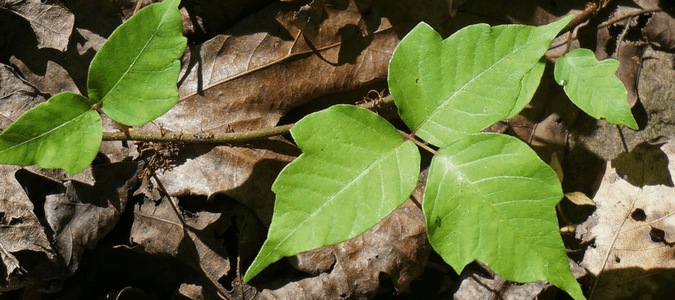
Grilling with friends, swinging in a hammock or lying on a blanket, gazing up into the trees: leisure time spent outdoors is what homeowners look forward to after a long day at work or during the weekends. But enjoying your outdoor living space—or just getting outside to do some yard work—can be a dicey prospect if you have pockets of poison ivy hiding on your property. This invasive plant produces a volatile oil (called urushiol oil) that can cause real injury to humans in the form of an itchy, blistering rash that develops after skin-to-plant contact.
Types of Poison Ivy and How to Identify Them
To avoid the unpleasant experience of dealing with the rash associated with contact with this plant, you’ll want to know how to identify poison ivy, including learning about the different types of poison ivy. If you know what to look out for, you can avoid this plant when you encounter it and even clear it from your property if possible.
Types of Poison Ivy
Did you know there are several different types of poison ivy? Some are more invasive than others, but all are potentially harmful to humans. Different states are home to different kinds of poison ivy, but there are two basic, distinct types: climbing and non-climbing poison ivy. As the names suggest, the first type is a climbing vine that can wind its way up fences, walls and tree trunks and into large bushes. The second type grows closely to the ground, either in small bushes or in single plants. Both the climbing and non-climbing types produce the oil that can cause an itchy, painful rash after contact with skin.
How to Identify Poison Ivy
Ever heard the phrase, “Leaves of three, let it be”? That phrase is a helpful one to remember and teach to family members, as it points to the single most identifiable characteristic of poison ivy: the fact that it grows in three-leaf clusters.
Here are the telltale signs of poison ivy:
- Leaves with pointed tips that grow in groups of three, clustered closely together on each stem of the plant. The middle leaf is typically larger and broader than the two leaves on the sides.
- Leaves typically emerge orange or red in color and then turn green in the summer. They often turn red, orange or yellow again in the fall.
- Some poison ivy plants will bear small, yellowish flowers in early summer or greenish-white berries in the late summer or fall.
- Poison ivy might grow in climbing vines, in shrub form, or as a ground cover that can grow up to a foot high or sometimes even taller.
- Climbing poison ivy vines can have a hairy appearance. This results from the plant’s aerial roots—small offshoots extending from the vine’s main stem that help the plant cling to the surface it’s climbing while drawing in moisture and nutrients from the air.
Poison ivy and poison oak look somewhat similar, as both plants grow in three-leaf clusters that are green in the summer and reddish in the fall, and both produce greenish-white berries. Poison oak leaves, however, are usually shaped more like real oak leaves, with jagged, uneven edges and rounded tips, while poison ivy leaves are more uniform in shape and pointed at the tips. Still, since both plants produce the same oil that can cause painful, itchy rashes, both poison ivy and poison oak are best avoided.
Where Poison Ivy Grows—and Why
The only areas of the United States where poison ivy does not typically grow are desert areas that are too arid to support the growth of this adaptable and invasive plant. Poison ivy also does not tend to grow in California. The rest of the country, however, has soil and climate conditions that are favorable for this toxic plant to grow.
Poison ivy is a hardy and invasive plant, which means anyone’s yard or property is fair game. Areas where deer live are more prone to poison ivy growth, as these animals eat the plant’s berries and then excrete the seeds, effectively planting new poison ivy plants. Poison ivy can also establish itself on properties that are heavily wooded or that have extensive gardens since poison ivy thrives in moist soil and among other plants that it can climb.
What to Do When You Encounter Poison Ivy in Your Yard
If you come into contact with poison ivy—or even if you think a certain plant you encountered might have been poison ivy—it’s best to err on the side of caution. Even touching only the vine itself (and not the leaves) puts you in danger of developing a painful rash. Here are some important steps to take as soon as possible after touching poison ivy, no matter the season:
- Clean skin immediately with vinegar or rubbing alcohol, if possible, and then wash with warm, soapy water.
- Wash all clothing and any garden tools you might have been using, as the plant’s volatile oil can cling to fabric and other surfaces.
- If your dog or other pet comes into contact with poison ivy, give the animal a bath or at least a good rubdown with a towel, to remove as much oil as possible from their fur. Otherwise, their fur might carry and transfer oil to your skin.
Clearing Poison Ivy
Clearing poison ivy from your yard can be a difficult and dangerous process. One important rule of thumb: Do not burn poison ivy in an effort to control its spread! Breathing in the smoke and fumes of burning poison ivy can be terribly caustic to the lungs.
The best way to clear poison ivy is first to protect the skin by wearing heavy-duty gloves, long sleeves, pants and boots and then pull the plant out of the ground by the roots. If any part of the root structure is left behind, the poison ivy can regrow, so be sure to dig it up completely. Once every bit of the poison ivy has been removed (and stored in a plastic garbage or yard waste bag for proper disposal), spread a thick layer of mulch to discourage future growth. It may also be wise to treat the area with herbicides to prevent a resurgence during the growing season.
Leave Lawn Care Hassles to the Professionals
Clearing poison ivy can be a difficult and time-consuming process, not to mention one accompanied by the danger of contracting a highly uncomfortable rash. Rather than removing poison ivy yourself, you may want to hire an authority in lawn care like ABC to remedy the problem for you. Our experienced professionals know the safest and most thorough techniques for getting rid of poison ivy, enabling you to enjoy your outdoor space risk-free.
